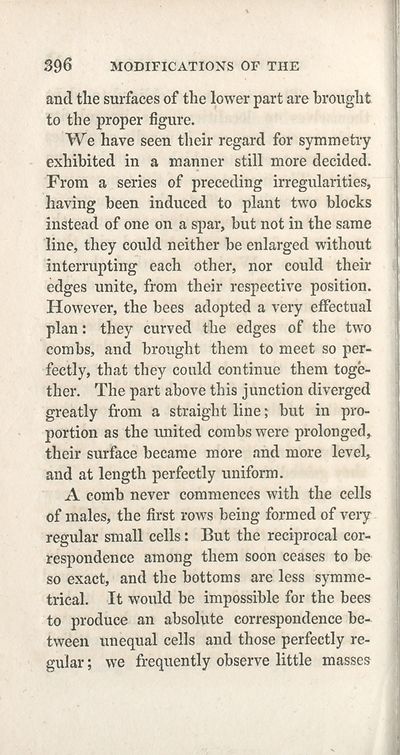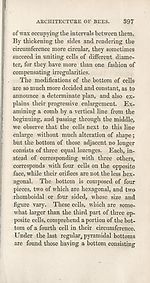Download files
Complete book:
Individual page:
Thumbnail gallery: Grid view | List view

396 MODIFICATIONS OF THE
and the surfaces of the lower part are brought I
to the proper figure.
We have seen their regard for symmetry !
exhibited in a manner still more decided.
From a series of preceding irregularities,
having been induced to plant two blocks
instead of one on a spar, but not in the same
line, they could neither be enlarged without j
interrupting each other, nor could their
edges unite, from their respective position.
However, the bees adopted a very effectual
plan: they curved the edges of the two
combs, and brought them to meet so per¬
fectly, that they could continue them toge- j
ther. The part above this junction diverged I
greatly from a straight line; but in pro¬
portion as the united combs were prolonged, ;
their surface became more and more level,
and at length perfectly uniform.
A comb never commences with the cells j
of males, the first rows being formed of very
regular small cells: But the reciprocal cor¬
respondence among them soon ceases to be
so exact, and the bottoms are less symme- j
trical. It would be impossible for the bees
to produce an absolute correspondence be¬
tween unequal cells and those perfectly re¬
gular ; we frequently observe little masses
and the surfaces of the lower part are brought I
to the proper figure.
We have seen their regard for symmetry !
exhibited in a manner still more decided.
From a series of preceding irregularities,
having been induced to plant two blocks
instead of one on a spar, but not in the same
line, they could neither be enlarged without j
interrupting each other, nor could their
edges unite, from their respective position.
However, the bees adopted a very effectual
plan: they curved the edges of the two
combs, and brought them to meet so per¬
fectly, that they could continue them toge- j
ther. The part above this junction diverged I
greatly from a straight line; but in pro¬
portion as the united combs were prolonged, ;
their surface became more and more level,
and at length perfectly uniform.
A comb never commences with the cells j
of males, the first rows being formed of very
regular small cells: But the reciprocal cor¬
respondence among them soon ceases to be
so exact, and the bottoms are less symme- j
trical. It would be impossible for the bees
to produce an absolute correspondence be¬
tween unequal cells and those perfectly re¬
gular ; we frequently observe little masses
Set display mode to:
![]() Universal Viewer |
Universal Viewer | ![]() Mirador |
Large image | Transcription
Mirador |
Large image | Transcription
| Antiquarian books of Scotland > Curiosities & wonders > New observations on the natural history of bees > (430) |
|---|
| Permanent URL | https://digital.nls.uk/128811027 |
|---|
| Description | Thousands of printed books from the Antiquarian Books of Scotland collection which dates from 1641 to the 1980s. The collection consists of 14,800 books which were published in Scotland or have a Scottish connection, e.g. through the author, printer or owner. Subjects covered include sport, education, diseases, adventure, occupations, Jacobites, politics and religion. Among the 29 languages represented are English, Gaelic, Italian, French, Russian and Swedish. |
|---|

